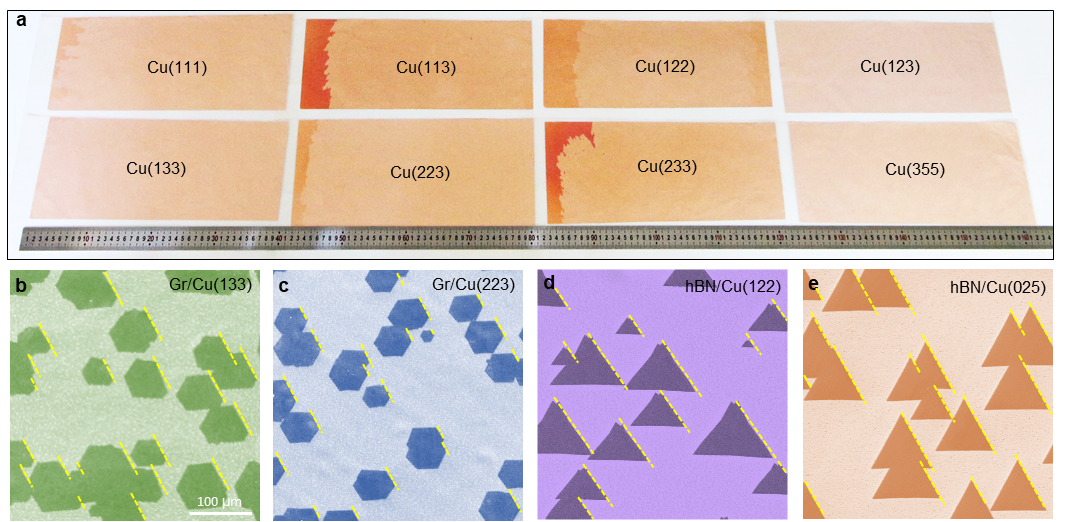The production of large single-crystal metal foils with various facet indices has long been a pursuit in materials science. Recently, a group of Chinese scientists has synthesized the largest single-crystal copper (Cu) foil.

Chair Professor Dapeng Yu (Institute of Quantum Science and Engineering), Researcher Kaihui Liu from Peking University (PKU), Chair Professor Enge Wang (PKU), and Professor Feng Ding (Ulsan Institute of Science and Technology) led teams to make vital progress in two-dimensional quantum materials. Their paper, titled “Seeded growth of large single-crystal copper foils with high-index facets,” was published today in the high-impact academic journal Nature (IF = 43.07)
Two-dimensional quantum materials exhibit many strange physical properties, in part due to being extremely thick and having a perfect surface interface. They are used in many different commercial applications, including conductors, semiconductors, and insulators. As can be seen, they have significant commercial applications and are fundamental for new technological applications.
The commercialization of high-end devices requires significant amounts of high-quality, two-dimensional single crystal materials in a single large piece. Preparing the substrates is the key to completing this procedure.
At present, high-index metal foils are mainly obtained by cutting bulk single-crystal metal ingots or by epitaxial deposition on other non-metal single crystals with a high-index facet. Thus, only a few index choices are available, and the cost is very high. Hence, new methods that enable efficient production of large single-crystal metal foils with various high-index facets are in high demand.
The researchers have been investigating this issue for many years and published several papers on this topic. As they have advanced their knowledge in the field, they have gotten closer to an optimal solution. However, the controlled preparation of high-index crystal facets has not shown thermodynamic or kinetic advantages. The preparation of large single-crystal metal foils is still a technical blank in the world.
The team applied the basic idea in high-index noble metal nanocrystal growth. The intention is to upset the thermodynamic equilibrium state of a low-index facet or modify the kinetic barrier to the growth of a high-index seed.

The thermodynamic advantage of a Cu(111) single crystal was broken with a mild pre-oxidation treatment of polycrystalline copper foils. Under further annealing, the Cu(hkl) grain seed with a size advantage spreads to the whole Cu foil by abnormal grain growth. Using this technique, the researchers can readily obtain large single-crystal Cu foils with various high-index facets. Statistical data further revealed that when the Cu foils were pre-oxidized, more than 30 facet types were obtained.
The team further proposed a facet ‘transfer’ method to copy the facet of the obtained high-index single crystals. That would control the production of the desired high-index single-crystal Cu foils. Being inspired by the idea of “genetics theory” in biology, the team put the prepared single crystal pieces with specific crystal orientation as “seed” on large-size commercial polycrystalline copper foil. Through their annealing process, they achieved a specific precision manufacturing of single crystal copper foil with A4 size. The experimental results also show that a variety of high-index single-crystal copper foils can be used as substrates for epitaxial growth. They could obtain uniformly oriented graphene and hexagonal boron nitride crystal domains as a result.
This achievement is the first to realize the controlled preparation of the single crystal copper foil library with the largest and the most complete crystal surface index in the world. Single-crystal manufacturing provides more substrate options for the preparation of two-dimensional quantum single-crystal materials.
This work will effectively promote the large-scale preparation of two-dimensional quantum single crystal materials, and is expected to promote the industrial application of new high-end quantum devices.
The co-first authors of the paper were Muhong Wu (PKU), Zhibin Zhang (PKU), Xiaozhi Xu (South China University of Technology), and Zhihong Zhang (PKU). Chair Professor Dapeng Yu, Researcher Kaihui Liu from Peking University (PKU), Chair Professor Enge Wang (PKU), and Professor Feng Ding (Ulsan Institute of Science and Technology) were the co-correspondent authors.
The research results have been strongly supported by the Natural Science Foundation of China, and several key R&D programs respectively issued by the Ministry of Science and Technology, Guangdong Province and Shenzhen.
Article link: https://www.nature.com/articles/s41586-020-2298-5
Proofread ByYingying XIA
Photo ByShenzhen Institute of Quantum Science and Engineering, Yan QIU